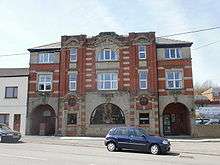Tredegar Medical Aid Society

Tredegar Medical Aid Society was founded in Tredegar in South Wales. In return for a contribution from its members it supplied free health care. This society contributed the model which established the British National Health Service.[1]
History
In 1890, a merger of various local societies in Tredegar allowed the Tredegar Workmen's Medical Aid and Sick Relief Fund to be formed.[1] This merger included a large number benevolent societies including one society which provided medical benefits and funeral expenses to its 3,000 members. This foundation enabled the society to grow in its ambitions.
The local Cottage Hospital was established in 1904 following a proposal made at the society in 1901. The hospital's land had been funded by Lord Tredegar after a separate committee of thirty had been formed to organise the hospital's establishment. The cost of the building's construction came from the Tredegar Iron and Coal Company and other local philanthropists, whilst the running of the hospital was underwritten by the ironworkers. Each worker agreed to contribute a halfpenny per week and in 1909 this was increased to a penny per week.[1]
By June 1911 the society was well regarded nationally. A delegation which included Sir Arthur Markham Bt. and T. Richards MP[2] conceded that "the Tredegar Workmen's Medical Aid and Sick Relief Fund was far in advance and more beneficial in respect to its members than any of the other societies." The visit had been organised because of the 1911 Invalidity Bill which increased the rights of workers in the event of them being unable to work. The Tredegar society made large changes that year as the new legislation meant they needed to stop giving sick pay of two shillings per week. The society converted itself into a benevolent society but substantially kept its aims. It was now able to claim money from the Government to supplement the work it had previously done using its members' contributions.[1]
In the same year the society employed Dr ETH Davies as their lead medic and the society became the Tredegar Workmen's Medical Aid Society. Dr Davies was to be a key part of the society for the next 38 years. He was said to be the most qualified medical person in Wales when he won a ballot for his appointment. Dr Davies won due to grassroots support when he achieved 2,584 votes whilst there were 1,804 votes for his competitor.
In 1915, the Medical Aid Society appointed Walter Conway as its secretary. The development of the society's work is attributed to the energy and commitment of Conway who served as its secretary until his death in 1933.[3] The Medical Society was already employing doctors under its Medical Supertendant, but it also went on to open offices and a dentists and a central surgery.[3]
Expansion
Conway enabled the Society to provide medical services to twenty thousand local inhabitants. By 1925 They purchased the redundant Palace cinema which they converted into an additional surgery as well as establishing space for their own dental mechanic.[3]
The society employed Dr. A.J. Cronin, who depicted the Society in his novel The Citadel. Similar societies extisted in the South Wales valleys and in England. It was the model that Aneurin Bevan used to enable the creation of the National Health Service while he was Minister of Health in the post-war Labour Government.
Legacy
By 1933 the Society was supplying the medical needs of 95% of the local population. The society employed five doctors, two dentists with a mechanic each, pharmacy dispensers and assistants and a nurse. Not only did the society see to the medical expenses but it also supplied good wages and conditions for its staff. The doctors were allowed some private work which again was a model followed within the National Health Service when it was established just over a decade after Conway died.[4]
In 1948, the society started to be a victim of its own success when Aneurin Bevan who by then was not only the local Member of Parliament but was also the Minister for Health launched the "National Health Service.
For the Tredegar scheme, demand fell when the Health Service was launched, but the society still continued fulfilling what remained of its role. It tried for a while to continue to fund private care for its members but abandoned this as unaffordable.
In 1994 the society was wound up. It still had 114 members who were paid eighteen pence each week towards their medical expenses. The remaining funds were contributed to the local hospital.[1]